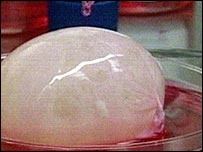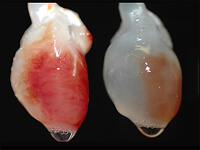Growing Organs in the Lab
Written on June 8, 2009 – 3:19 pm | by Drew Halley |
Why transplant an organ when you can grow yourself a new one?

A homegrown bladder (Photo courtesy of BBC)
This research isn’t something that might happen in the distant future. It’s being used today to grow fresh organs, open up new ways to study disease and the immune system, and reduce the need for organ transplants. Organ-farming laboratories are popping up across the planet, and showing impressive results. Here we look at the state of the union of a rapidly advancing field called tissue engineering: what’s been accomplished so far, and what’s right around the corner.
Patients who undergo organ transplants require loads of toxic drugs to suppress their immune systems; otherwise their body might reject the organ. But tissue engineering could make organ transplants a thing of the past. By using a patient’s cells to grow new types of tissue in the lab, researchers are finding new ways to custom-engineer you new body parts by using your own cells.
At the cutting edge of organ engineering is Tengion, a clinical-stage biotech company based outside of Philadelphia. Their most successful research to date led to the creation of the Neo-Bladder. Tengion takes some of your cells and grows them in culture for five to seven weeks around a biodegradable scaffold. When the organ is ready, it can be transplanted without the need to suppress the patient’s immune system (because the organ was grown from the patient’s own cells, it carries no risk of rejection). Once the organ is in, the scaffold degrades and the bladder adapts to its new (old) home.
The Tengion Neo-Bladder is in Phase II testing, meaning that they have already implanted the organ into individuals and studied how the body adapts to it. After 5 years, the company was able to show that the homegrown organs are safe and effective, capable of treating the bladder effects of spina bifida (a neural tube defect that effects bladder function, among other things). After another round of Phase II trials, Tengion will move on to Phase III testing; after that, the Neo-Bladder should be approved and be made commercially available.
Tengion’s Neo-bladder is nearing the completion of its clinical trials, but they weren’t the first to grow one. If anyone on Earth deserves the job title “Organ Farmer,” it’s Dr. Anthony Atala. He and his research team at Wake Forest University Medical Center pioneered the world’s first lab-grown bladder, and they remain at the forefront of the organ-growing field (Atala is also the chairman of Tengion’s scientific advisory board). Wake Forest is the world’s largest regenerative medicine research center, and their current research is growing 22 different types of tissue: heart valves, muscle cells, arteries, and even fingers.
So how many different types of human organs have been grown and transplanted? The lab-grown bladders are among the only transplants of an entire organ, but a wide variety of partial organ transplants have taken place. Skin cells are regularly grown in culture and grafted onto patients’ bodies. A graft was grown from a patient’s trachea cells and transplanted to replace part of her airway that had degraded due to disease. Cartilage has been grown and transplanted into a patient’s knee.
A number of technologies are under development but have yet to be transplanted into human bodies. Recently, Dr. Nicholas Kotov and his lab at the University of Michigan have engineered artificial bone marrow, a task that was previously doomed to failure. Kotov and his colleagues realized that in the body, stem cell differentiation relies on chemical signals in three dimensions (whereas in a petri dish, it takes place in two dimensions). This insight led to a new methodology that more closely replicated the natural environment of stem cell differentiation in bone marrow tissue. The resultant homegrown marrow grew and divided normally, even releasing antibodies in fight off an introduced influenza strain. It can be used to study the role of bone marrow in fighting disease within the body, as well as creating a “bioreactor”: harnessing the artificial marrow within a device to grow cells and tissues.
Tengion is pretty busy these days as well. Their new website lists a variety of new applications on the horizon, including a Neo-Kidney augment, artery replacements (including in the heart), and variations on their bladder technique to replace cancerous organs. Their company pipeline gives a general idea of the relative stages of each project.
A number of initiatives are under way to create an artificial pancreas, which would revolutionize the way we treat diabetes. By providing diabetics with a healthy pancreas, doctors could restore their natural control of blood glucose by giving them an endogenous source of insulin. Anyone with experience of diabetes knows the difficulty of manually monitoring and controlling your sugar levels, not to mention regularly injecting insulin. A lab-grown pancreas replacement would be an incredible benefit to the 23.6 million individuals in America alone who suffer from diabetes.

The Minnesota rat heart
As we previously reported, researchers at the University of Minnesota grew an entire rat heart in a laboratory last year. Their next goal is to grow a pig heart, a significant milestone towards growing a human heart due to their similar structure. Researchers hope to combine the scaffold of a pig heart with human cardiac tissue to grow a hybrid heart suitable for transplant.
Another exciting frontier is the field of printable tissue and organs, which is just what it sounds like. Inkjet cartidges are cleaned out and loaded with a mixture of live human cells and “smart gel.” Then, layer by layer, the cells are printed atop one another until a 3D organ is constructed. Just as a normal printer can deposit different colored ink, organ printing allows scientists to specify where to place different cell types. Organ printing has already created beating cardiac cells, and could soon produce organs that are viable for transplant. But unlike other 3D printers, I wouldn’t want this one in my living room.
The hottest areas in tissue growth are the types hardest to make: nerve, liver, kidney, heart and pancreas cells. But these are precisely where Alata and Tengion are heading, pushing the industry into fresh territory. Coupled with new regenerative treatments like Cook biotech’s foams and stem-cell organ patching, tissue engineering will be keeping our organs young and healthy in the years to come.
Merely a decade ago, tissue engineering was still a new field that struggled to find funding and support. Today, thousands of scientists worldwide are coordinating efforts to reach new breakthroughs, and the demonstrated potential of these methods has helped bring in investors. That should keep the organ growing field moving forward in the future months and years, and we’ll be covering new advances as they emerge.
Check out this Wired Science video that tours around Atala’s lab:






1 comments:
[b][url=http://www.uggsaustraliawebsite.com/]ugg australia boots[/url][/b] For females who wish to try a thing daring and are not frightened to receive attention, the Rihanna fashion entire lace wig is for them. For people that are additional hesitant from the rocker choppy lower which the star has, a full lace wig can be altered for just a a lot more female glimpse. As it is made of remy human hair, you'll be able to develop a curly seem to the small minimize.
[b][url=http://www.cheapuggbootsonlineshop.co.uk/]cheap ugg boots[/url][/b] It's normally getting stated that 1 really should search for your modified type of home furniture products which encover a lot less place. The home furnishings stores around extended island, ny made use of to include pro brands of home furniture products who're effective at production the superb form of furniture things which can be differentiated when compared with other individuals. One of several finest items about them is always that, whether or not a single is endeavoring to pick out the furniture products for sake of tiny property or a big home, there are actually great varieties of unique home furniture things which happen to be manufactured out there within this regard..
[b][url=http://www.louisvuittonoutletsonline.co.uk/]cheap louis vuitton[/url][/b] Tag Heuer claimed, this initiated move made it the 1st luxury enjoy model that provide on line secured looking for its all luxurious look at items. The joined stores said it could tremendously assist Tag Heuer enlarge its organization. As what LV North The us President stated, our electronic commerce program would supply Tag Heuer prospects with hassle-free on line browsing whose safety and repair could compare with their preferred merchants..
[b][url=http://www.fashionuggbootsstore.co.uk/]ugg uk[/url][/b] Happily you row the boat to the other shore. There, you find a desert, which you should cross, so that you can get to your vacation spot. You place the boat with your shoulders and begin crossing the desert. If you would like to operate out your decrease entire body, phase within the middle in the resistance band with the two your feet. Your ft must be shoulder-width apart. Keep a different stop from the band with both of those both hands, keeping your hands at shoulder-width.
[b][url=http://www.uggsaustraliawebsite.com/]www.uggsaustraliawebsite.com[/url][/b] A faux Louis Vuitton clutches will definitely have got a airborne dust and mud bag of which seems to be cost-effective, likely often wrinkled, possibly not measured efficiently to fit your bag, dangling threads, together with the in addition for the provider brand might have close to Paris posted within the prominent. some. Materials-Real Louis Vuitton bags are created with all-natural cowhide leather-based of which spins a thicker hue as time passes and with make use of.
Post a Comment